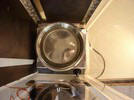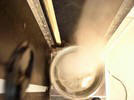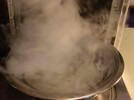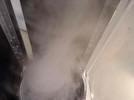The Physics of Tornadoes and Hurricanes |
||||||||||||||||||||||||||
| Archimedes Principle |
Tornadoes and hurricanes are weather phenomena that are examples of physical vortexes.
A tornado is a violent windstorm with a twisting, funnel shape cloud and is usually spawned by thunderstorms when cool air and warm air meet, forcing warm air to rise quickly. Damage from tornadoes are due to high speed winds and flying debris. |
|
||||||||||||||||||||||||
|
|
A hurricane is tropical storm which also has a twisting, funnel shaped form but is much larger than a tornado. In the centre of a hurricane is a calm area called the "eye". High winds, torrential rain, floods, and storm surges caused when hurricanes come near or over land result in significant damage over large areas. |
|||||||||||||||||||||||||
| We'll examine a few of the physics aspects of how hurricanes and tornadoes form. | ||||||||||||||||||||||||||
Archimedes Principle |
||||||||||||||||||||||||||
| Archimedes's Principle says that a body
immersed in a fluid is buoyed up by a force equal to the weight of the
displaced fluid.
The relative density of the object compared to the density of the fluid determines whether it will sink or float. The pressure due to the fluid is equal to pgh (density times acceleration due to gravity, times height) and when applied to an area, gives the force. |
|
|||||||||||||||||||||||||
| Therefore the force at the top of the object
is:
P1A
= pfluidgh1 A
and the force at the bottom of the object is: P2A = pfluidgh2 A so the buoyant force pushing up on the object is:
Fb
= F2 –
F1
= pfluidgA (h2-h1)
= pfluidgAh
= pfluidgV
which is the density of the fluid, times acceleration due to gravity,
times the volume of the fluid displaced.
|
The formula: Fb
= pfluidgV
applies not only to a rectangular object, but can be generalized to an object with any shape. If the buoyant force is more than the weight of the object, this means that the object's density is less than the fluid's density. This results in the object rising or floating up. If the buoyant force is less than the weight of the object, this means that the object's density is more than the fluid's density. This results in the object sinking. |
|||||||||||||||||||||||||
| Also when objects are heated, they expand. density formula: p=m/V, where p is density, m is mass, and V is volume When a pocket of air is heated, it expands and the volume increases, thus density decreases. And if the density of the air pocket is less than the density of the surrounding cooler air it will rise.
|
Rising air in the centre meets less resistance
because it is surrounded by air that is also rising. Rising air creates a vacuum causing cooler air from the sides to move in to replace the rising air. This causes a wind which further pushes the rising air. |
|||||||||||||||||||||||||
Angular Momentum |
||||||||||||||||||||||||||
| Ordinary linear momentum is a measure of an
object's tendency to move at constant speed along a straight path.
Linear momentum depends on speed and mass.
When objects moved in curved paths, we can generalize the idea of linear momentum to something called angular momentum, an object's tendency to spin. Like linear momentum, the total angular momentum of an isolated object is conserved. Imagine an object with mass, rotating around an axis. Here, the angular momentum is the product of its mass, velocity (tangential), and radius (the distance from the axis point around which the object is spinning around).
L = mvr
|
|
|||||||||||||||||||||||||
|
|
Note that this applies to an object that has
its mass at the distance r from the axis.
However, we can generalize this to an object whose mass is distributed all along the distance r and not just at the end of that distance r. For example, the body of a figure skater has most of its mass near the axis of rotation, and the mass of his or her arms and hands at a farther distance out. Let us assume all the mass is at the distance r from the axis of rotation. Conservation of angular momentum then explains why figure skaters or divers spin faster when they bring in their arms or tuck themselves in a roll. |
|||||||||||||||||||||||||
| For angular momentum to conserve in a spin,
the angular momentum before must equal the angular momentum after. The mass of the figure skater doesn't change. So if the radius decreases (by the skater bringing in their arms), then the velocity increases. |
Lbefore = Lafter mviri = mvfrf |
|||||||||||||||||||||||||
Rotational Force |
||||||||||||||||||||||||||
| Acceleration is the change of velocity in a
short period of time:
a=Δv/Δt
When an object is rotating around something, the acceleration force to keep it rotating is: F = ma = m v2 / r The acceleration causes the direction of velocity to continually change to keep it rotating. When you swing a ball on a string, you exert a force on the string, causing a tension, which then exerts a force on the ball. At the same time, the ball exerts an equal amount of force in the opposite direction. The ball exerts a force on the string, causing a tension, which then exerts a force on your hand.
|
 |
|||||||||||||||||||||||||
Coriolis Force |
||||||||||||||||||||||||||
|
In a rotating frame of reference, it is an inertial force acting to the right of the direction of movement when rotating counter-clockwise and to the left of the direction of movement when rotating clockwise. It occurs because the Earth rotates eastward and it rotates faster (tangentially) as you approach the Equator and slower at the poles. |
 |
|||||||||||||||||||||||||
| The Coriolis force is very, very weak and plays an insignificant role in the spinning of water in a sink or a toilet. The way the water spins is more likely due to the oval shape of the bowl or the off centre drain. | On the scale of large storms and hurricanes,
the Coriolis force causes air to rotate around the centre in a cyclonic
direction (counter clockwise in the northern hemisphere, clockwise in the
southern hemisphere).
|
|||||||||||||||||||||||||
Tornadoes |
||||||||||||||||||||||||||
| The funnel of a tornado is visible due to the
condensation of water vapor from the pressure of the spinning wind. They have damage paths that can be 1.5 km wide and up to 75 km long. There is enough force to pick up cars and rip homes to shreds, turning the debris into potentially lethal missiles. There are an average of 1000 per year reported in the US and result in around 80 deaths and 1500 injuries (NOAA). More tornadoes form in the mid western United States than any where else in the world. They usually occur in the fall and spring. |
 |
|||||||||||||||||||||||||
 |
Steps of formation:
|
|||||||||||||||||||||||||
Fujita Scale |
||||||||||||||||||||||||||
| The Fujita Scale classifies tornadoes
according to the damage they cause. This is because the size of a tornado
is not an indication of its intensity and so there can be large but weak
tornadoes or small but powerful ones. It does try to link wind speeds with damage. However, there are some problems with this measurement system:
note: No F6 tornadoes have been officially reported as the winds are highly unlikely and they would probably be classified as strong F5's. F6 would be difficult to determine as there would be no objects left to study. |
 |
|||||||||||||||||||||||||

|
|
|||||||||||||||||||||||||
| Below is are pictures before and after of an F4 tornado hitting a factory in Roanoke (July 13, 2004) | ||||||||||||||||||||||||||
|
|
|
|||||||||||||||||||||||||
Hurricanes |
||||||||||||||||||||||||||
Hurricanes form in the tropics where the air
and water are warm and moist.
|
|
|||||||||||||||||||||||||
|
|
||||||||||||||||||||||||||
Demos |
||||||||||||||||||||||||||
|
Conservation of Angular Momentum A person sits in a rotating office chair hold their arms out at full reach. The person is also carrying a dumbbell around 10 lbs or so in each hand. He or she starts spinning the chair and during the spin, the person quickly brings in their arms towards their chest. This will cause them to spin faster. The person can then quickly bring their arms out and that will quickly slow down the spin. |
||||||||||||||||||||||||||
|
Vortex Bottles These are essentially two 2L pop bottles with a special joiner. One is filled with water and food coloring and/or sparkles which make it more visible. The other bottle is kept empty. Flip the bottle so that the colored water is at the top. Spin the bottle at the top end in either direction then let it go and a vortex will form as the water drains to the bottom empty bottle. |
||||||||||||||||||||||||||
|
Hurricane in a Box A box is made with dimensions around 12 inches wide and 30 inches high, with the back, left side, and bottom made of plywood and the front and right sides made of Plexiglas. The back and left side wood is painted black for better visibility. On each of the sides of the box, a 1 inch slit is carved out about 2 inches from the right of the edge. These slits provide the rotational spin to the column. A metal plate of water is brought to boil and soon a column of steam is visible. As the air above the water is heated and as water evaporates, the air rises. Cooler air is brought in through the slits of the box and the column of air and steam starts spinning due to the offset slits. Liquid nitrogen was put into the boiling water to make the funnel very visible. I think the effect is quite impressive. The hurricane box was based off the plans from tornadoproject.com (see Link and Resources section) |
||||||||||||||||||||||||||
Links and Resources |
||||||||||||||||||||||||||
|
http://www.tornadoproject.com/cellar/workshop.htm http://www.reelefx.com/Tornado/Factsheet.htm http://www.reelefx.com/Tornado/tornado.htm#Volvo http://scifun.chem.wisc.edu/WOP/Vortex.html http://www.spc.noaa.gov/faq/tornado/index.html#The%20Basics http://wind.mit.edu/~emanuel/fphysics/ps3.htm http://www.geocities.com/bowlturner/my_weatherpics.html http://home3.inet.tele.dk/hitower/vortex.htm http://www.amasci.com/amateur/tornbox.html http://www.facethewind.com/tornsim/tornsim.html http://www.sciam.com/search/index.cfm?QT=Q&SC=Q&Q=vortex http://web.idrc.ca/en/ev-37540-201-1-DO_TOPIC.html |
||||||||||||||||||||||||||




































